Double exposure
June 24th, 2008, by Francesca
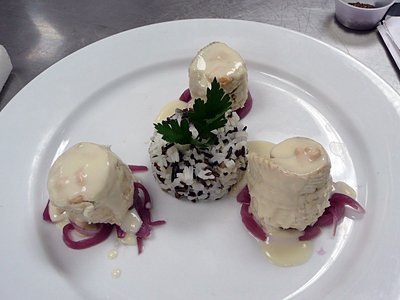
One chef's sole vin blanc
Last Tuesday I went to school for two shifts in a row, to make up for the time I was going to miss on Wednesday. Our program includes three shifts: schedule A, B and C, so if you miss a class you can make up by going to a different schedule. In my case, I wasn't really making up because I missed the Wednesday dishes and got to cook the Tuesday dishes twice instead, but by doing so I wasn't penalized from the point of view of grading. Me caring about grades may surprise you, but without a good GPA I won't be eligible for an international externship, which is what I would like to do next spring, after I am done with all my classes.
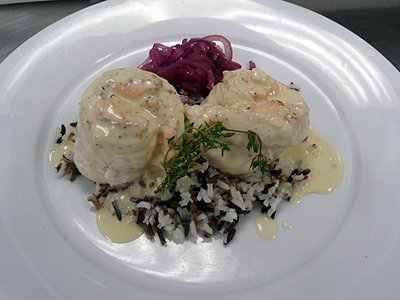
Another chef's sole vin blanc
Schedule B – the only sane choice for me – goes from noon to 5PM (actually it ends up being six hours, but still manageable). Schedule A and C fall in the insane realm: 6AM-11AM and 6PM-11PM, times where I cannot be trusted to be conscious enough to handle sharp knives and hot burners.
So, Tuesday I was running around the lab like a headless chicken for eleven hours straight, not an experience I care to repeat. Sleepiness and feet+back pain aside, it was extremely interesting to see how differently two chefs can run their ship and cook the same dishes.
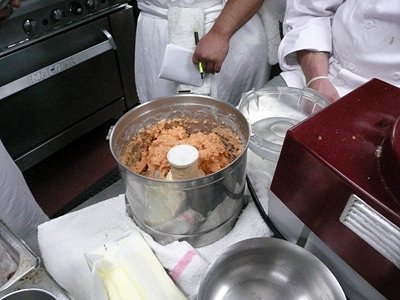
We used this Robo-Coop to make salmon mousse
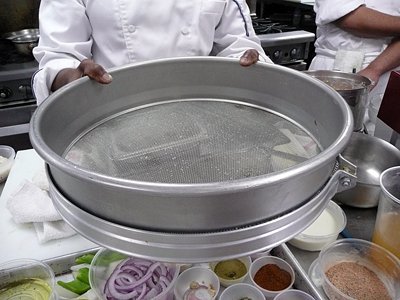
and we passed it through this sieve, called "tamis"
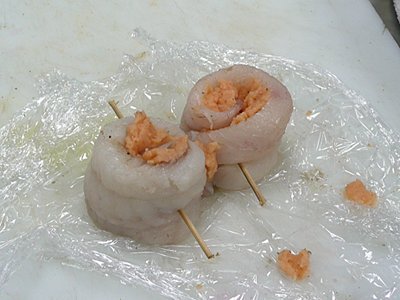
Sole paupiettes with skewers
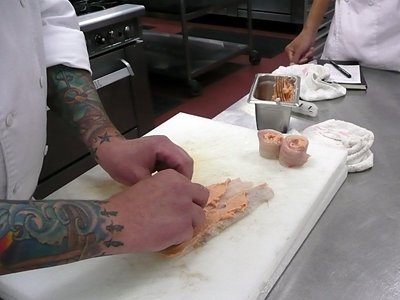
and without
The morning lab has only one class with about ten students, while our lab includes two classes for a total of 32 students; that alone causes logistic differences in prep and cleaning routines. We clean individually as we go and work as a team only after we have presented our dishes. In schedule A, students drop dirty items in the sinks and when those are full, they all pitch in to wash and put away pots and pans. That system would not work in a class our size.
The really interesting part, though, was watching two demos and cooking the dishes twice. Our dishes for the day were Sole Vin Blanc and Shrimp Gumbo.
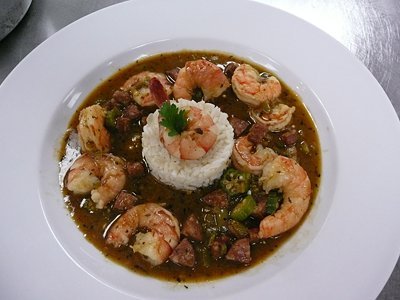
My morning gumbo
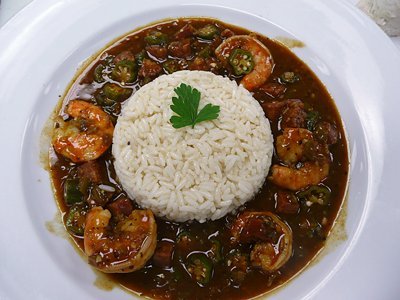
My afternoon gumbo
In the course of the day I learned:
- two ways to gut a flat fish
- two ways to clean a shrimp
- two ways to make paupiettes
- two ways to plate the dishes
Other differences that day were:
- one chef made the salmon mousseline for us, while the other had us prepare it
- in one class we made fish fumet in groups of 5-6 students, in the other we made it individually
As luck has it, shrimp gumbo is one of the dishes I have to cook for my finals. We pulled menus yesterday and today we prepped for the next two days of cooking.
Tomorrow my dishes will be:
- French onion soup
- Grilled Mahi-mahi, sautéed vegetables, ginger-lime beurre blanc and (maybe) rice pilaf
- Poached salmon fillet, steamed broccoli, sauce Béarnaise and gaufrette potatoes
Wish me luck!
When a butt is a shoulder
June 22nd, 2008, by Francesca
Chuck, rib, loin, round…
Shoulder, rack, loin, leg…
Tinker, tailor, soldier, sailor…
Prime, choice, select, standard, utility…
Prime, choice, good, standard, utility…
Prime, choice, good, utility, cull…
Meat terminology alone makes me want to turn vegetarian.
Why is a cow's shoulder called chuck, a veal's shoulder a shoulder and a pig's shoulder a Boston butt? But the butt is called ham or leg, of course. And Monsieur le porc has another shoulder apparently, called picnic shoulder.
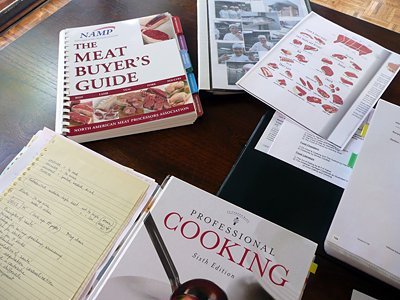
Meat grades are even worse: the same term means different things when applied to different animals. To make things more interesting still, veal is graded for quality but not yield, and pork grading is combined for yield and quality. Do you see why I am going crazy studying for finals?
And what to say about cooking temperatures for various degrees of doneness? The Gisslen says one thing; one set of school handouts another, and another handout gives yet different temperatures. I should just take the day off.
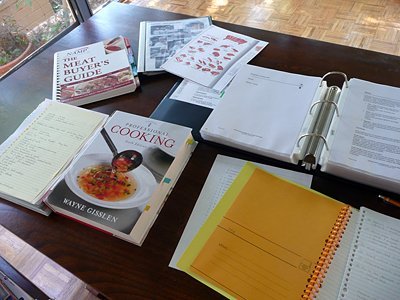
At least my notebook is finished and this term I have a top notch notebook, if I can say so myself.
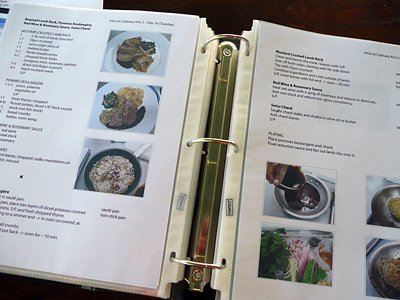
Roasted lamb chops
This time I have photos and notes for all the recipes and various fabrication techniques. Talking about shoulders… pat, pat.
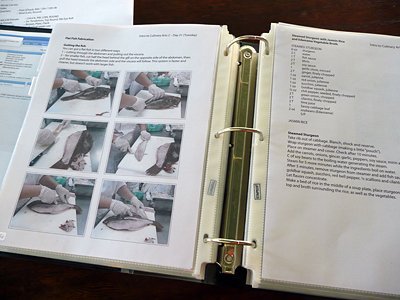
Fabricating a flat fish
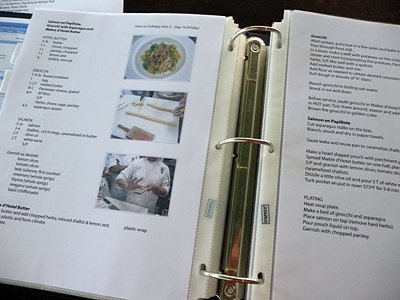
My first gnocchi
Well, this was a good break but I do have to get back to study. In addition to all the material from this term, I have to go over all the stuff from Intro 1.
Stay cool out there, wherever you are. Our old house is melting and we are keeping our fingers crossed that the neighborhood's A/C units don't cause a black-out.
Passatelli in brodo
June 20th, 2008, by Francesca
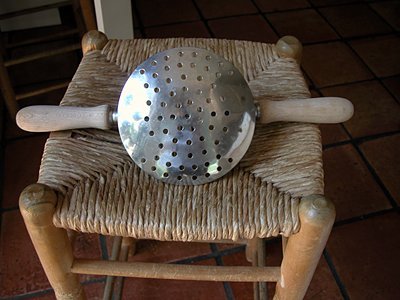
Remember the dish I picked for my interpretation of Chicken Noodle Soup a few weeks ago? That was passatelli in brodo, a typical broth dish from Romagna, more specifically from Lugo di Romagna, a small town near Faenza, where I spent most of my time growing up. I love passatelli in brodo. It's a winter dish, but if I get a twinge of homesickness or food nostalgia, I don't care what time of year it is. Call it comfort food or whatever; it's the kind of thing that just makes me feel better.
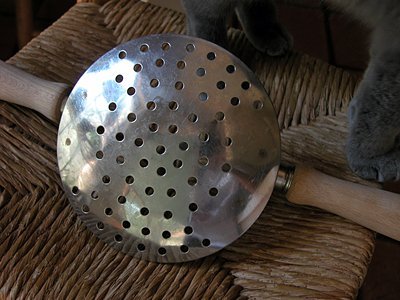
I know most of my readers are in the northern hemisphere, but at least a couple are down under (hi, Steve and Gaby!) so this might be a timely recipe for them and the rest of you can just file it away for next winter.
If it weren't for the liquid/puréed diet I am on for another couple of days, I would not have made passatelli on a day like this: 106ºF (41ºC). Yes, it's insane, but there's only so much yogurt and ice-cream I can eat in one day.
The strange looking thing in the photos above is the traditional tool used in Romagna to make passatelli, but…
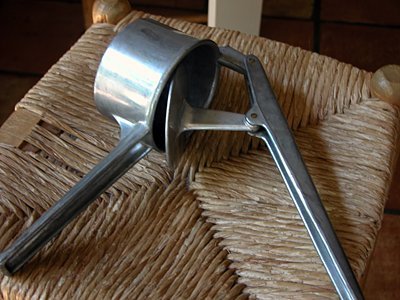
a ricer like this one will do just fine.
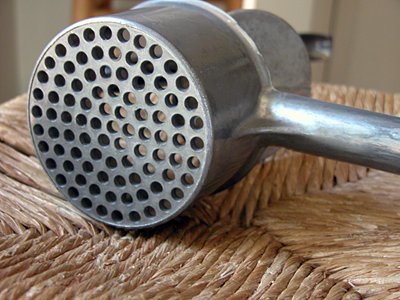
Ingredients (serves 4)
- 100 gr
- Parmesan cheese, grated
- 100 gr
- breadcrumbs, small
- 3
- eggs
- 1 lt
- chicken broth
- 30 gr
- butter
- nutmeg
- salt
- black pepper
- lemon zest (optional)
In a bowl, mix the breadcrumbs and Parmesan cheese with the melted butter, the whole eggs, a pinch of nutmeg, a big pinch of salt, the ground black pepper and the lemon zest. I've only recently started to add the lemon zest and I like the brightness it brings to the dish. I go easy on lemon zest, pepper and nutmeg.
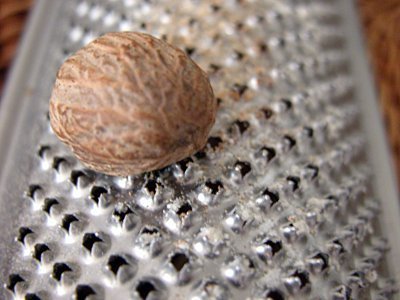
The mixture has to be rather stiff; if it’s too soft, add more breadcrumbs and Parmesan. Mine was a little too stiff this time and my little worms broke too soon. Part of the problem was that I didn't have good breadcrumbs.
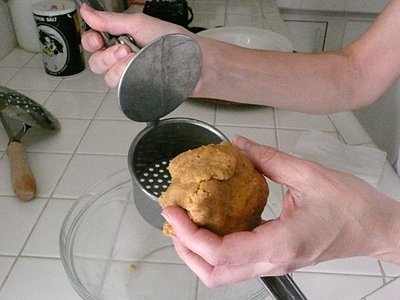
Pass the mixture through the ricer (it has to offer a good resistance) and cut the little “worms” when they are about 2 inches long. You could even do this over the boiling broth.
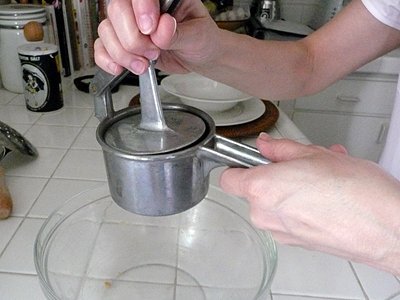
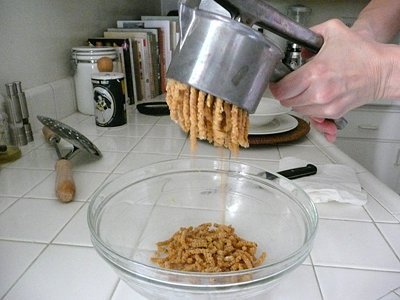
I should have dropped the passatelli on a tray and spaced them apart, but I forgot.
Bring the seasoned broth to boil in a pot, and drop the passatelli. They cook in less than 5 minutes. Serve immediately.
In the past few years, restaurants in Romagna have started to cook passatelli in broth and then drain them to serve them pasta-style with ragù or other condiments. I haven't tried them that way yet, so I don't have an opinion. Next time I go to Italy, I'll put that on my to do list.
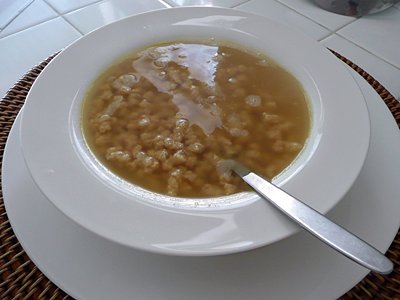
By the way, this is a dish that really benefits from a good homemade broth, and the perfect broth for it would be brodo di cappone (capon broth) or brodo di manzo e gallina (beef and hen broth). Passatelli are one of several traditional Christmas dishes in Romagna, usually followed by bollito misto, mixed boiled meat and vegetables used to make the broth. I admit that I didn't make my own broth today and the dish suffered from that.
For those of you who like their broth super clear – consommè style – this may not be your cup of tea, as the passatelli tend to cloud the broth. Like most (all?) dishes from my beloved Romagna, this is a rustic plate.
Oh, one more thing… use the best Parmigiano you can find (Parmigiano Reggiano, freshly grated) and whatever bread you choose, please don't use sourdough or you'll make me cry.
Errata
June 20th, 2008, by Francesca
A necessary correction to my post of June 1.
The cut of beef we used for the Italian style pot roast was chuck, a cut from the shoulder, not tenderloin. Sorry about the confusion!
Buffet Day
June 19th, 2008, by Francesca
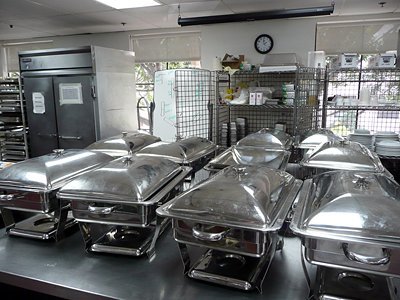
Are we ready yet?

Where's the food?

Our friends and families are waiting… will we make it in time?
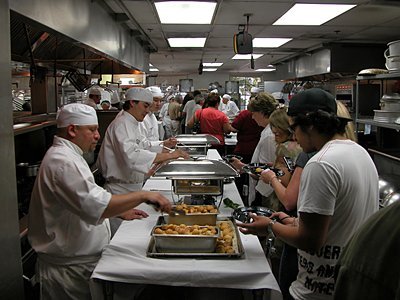
Yes! Let the feast begin…
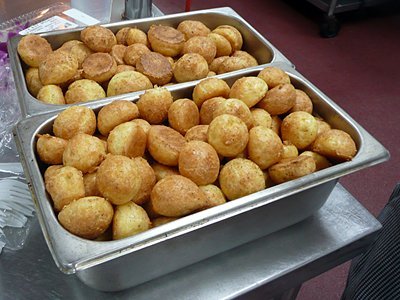
with savory beignets, pea soup, veal stew…

and beef bourguignon.
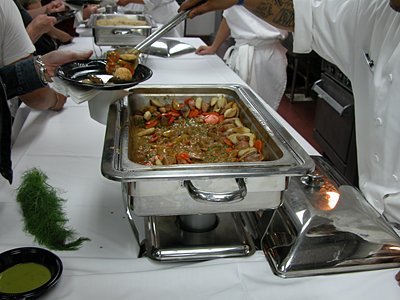
Poached salmon and sturgeon…

herb encrusted sturgeon in the chafing dish…
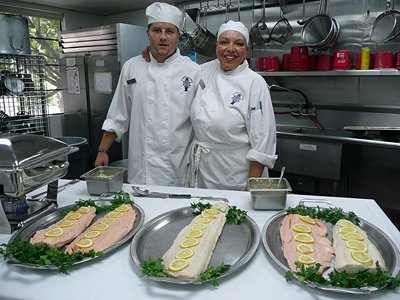
not to mention the roasted legs of lamb…
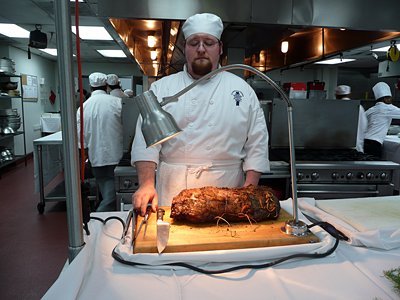
and loads of neglected veggies. Yes, all those veggies we poached in wine and spices sat there forlorn in the middle of the lab. By the time our guests got to that table, their plates were already filled with meat and fish and they were eyeing the duck salad on the other side.

Poor veggies; how could they compete between the salmon and the cheesy creamed mashed potatoes?

Asparagus gratin, anyone?
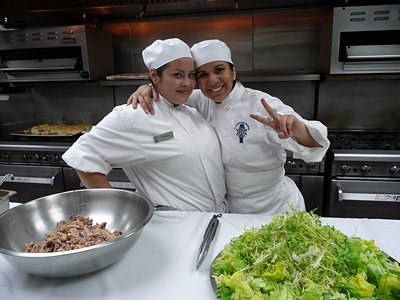
The duck salad girls… someone please explain to me how come they always come out well in photos while I invariably look like an earthquake victim?
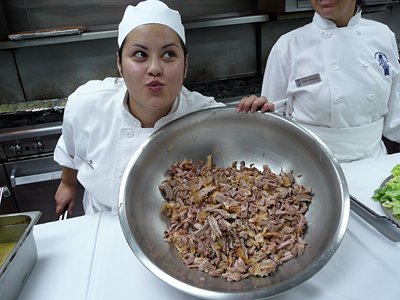
We used one lab to cook and serve most dishes, and another lab for people to get drinks and desserts and find a seat to enjoy their meal.
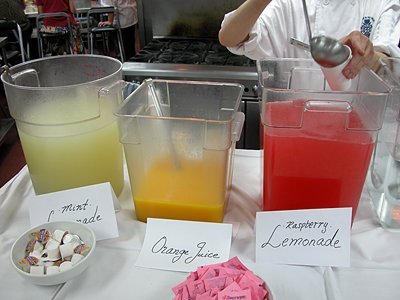
No wine, as usual. Remind me to say something about that when I get the next student satisfaction survey.

After all our guests were served at least once, we took turns in taking short breaks to go mingle with them and grab a bite to eat.
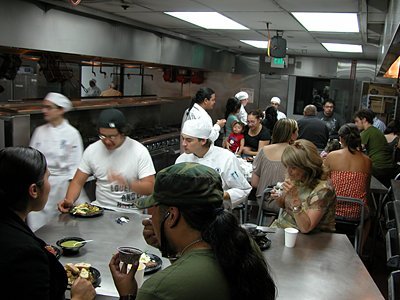
The desserts were so good. I was too busy enjoying them to focus on taking pictures.
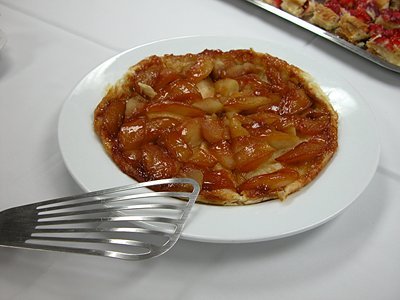
Since yesterday I had periodontal surgery, I can only eat liquid or pureed food for a while and I couldn't taste anything other than the pea soup, mashed potatoes and the pot de crème.

Well, yes, I did grab a few strawberries from the strawberry tart.

A tired moment at the end of the day.

And a strawberry moment…
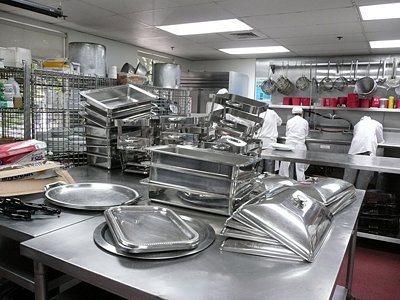
before the inevitable clean-up.
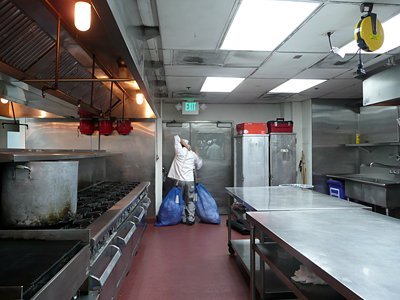
This was our first time cooking large quantities of food and also cooking for someone other than ourselves. Things turned out well and I enjoyed meeting some of my friends' families and friends.
The three whisketeers
June 16th, 2008, by Francesca
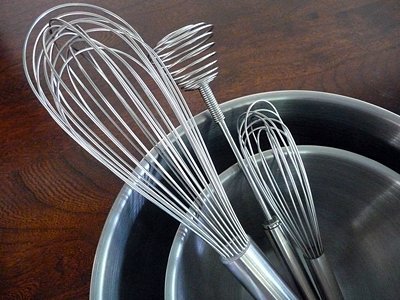
My culinary arsenal includes three whisks, that I use differently for specific tasks not because of training, but personal preference.
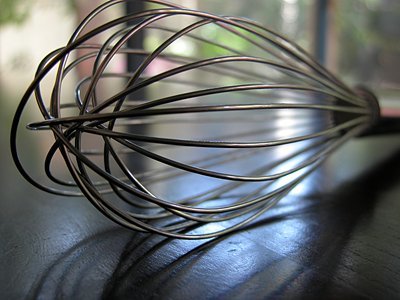
My school kit came with a large oval whisk – the kind you most often think of when hearing the word "whisk" – so I assume this makes it the de facto recommendation of Le Cordon Bleu. Or maybe it's the deal they have with their chosen supplier (yes, I am cynical), who knows. Regardless, if you had to have just one whisk, you'd probably want this one, for its versatility.
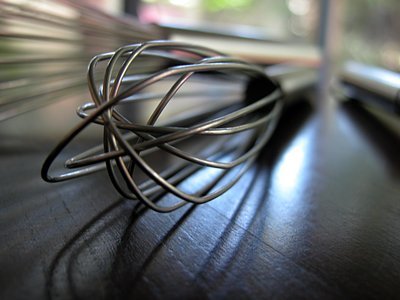
This smaller whisk I like for stirring reduction sauces, béchamel, and pan gravies.
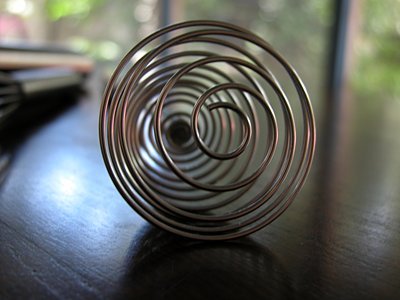
And this one… well, I'd like to tell you that I had a clear plan when I bought it, but the truth is that I saw it one evening while shopping for a chinois at Sur La Table, and bought it on an impulse. The guy working the late shift that day told me that it's good for eggs and I took his word for it. As it turns out, some of the young sales people at Sur La Table are graduates from my school (hmm… what does that say about job prospects?).
After trying it out, I love it to get emulsions started. For me it makes the starting phase of sauces such as Hollandaise and mayonnaise easier and faster, then I switch to the large oval whisk, especially if I am making a good size batch.
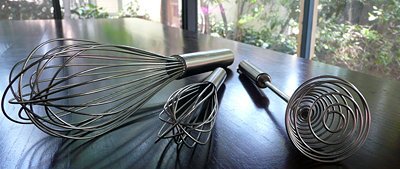
After a few weeks of culinary school, my take on things is that you'll find as many arguments in favor of a particular tool as you can find against. It really comes down to what works for you. You may not be aware of why you prefer something, but I bet you have a good reason for it: the size of your hands, right- or left-handedness, the task to be performed, the amount of food being processed, the size of another tool or container, old habits…
So, don't take my word for any of this and try things out for yourselves!
Salame al cioccolato
June 15th, 2008, by Francesca
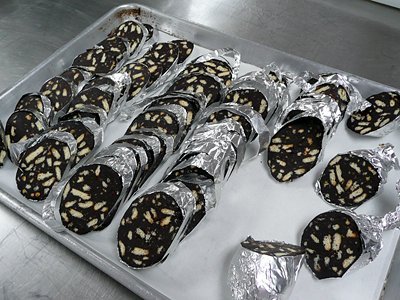
The bad news: this is a calorie bomb. Be warned and don't come complaining to me when those jeans don't fit; I won't have any of that.
The good news: it's super easy – messy, but easy – and there is no cooking involved. Oh, and you get a good upper body work-out, too, to offset some of those calories.
Warning: this contains raw eggs. I never worry about this, coming from the land of zabaglione and spaghetti alla carbonara, but if you do, consider using pasteurized eggs.
Ingredients:- 2
- egg yolks
- 100 g
- fine sugar
- 100 g
- unsalted butter
- 100 g
- unsweetened cocoa powder
- 1
- small glass of rum
- 150 g
- dry tea biscuits
- Equipment:
- stainless steel or glass mixing bowl
- wooden spoon (reserved for desserts only)
- strainer/sieve
- scale
A note about measurements:
If your scale doesn't do metric, remember 100 grams = about 3.5 ounces. If you have no scale, then I'm no help because I use metric or US systems based on the recipe at hand, but I hardly ever try to convert from one to the other. Brain hurts… but I should be more helpful after I take Applied Math next term.
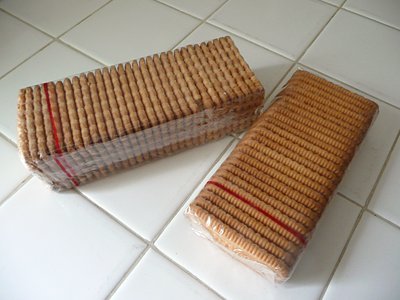
Dry tea biscuits (biscotti secchi): I bought mine at a local Armenian store. Any kind of dry biscuit/cookie will do.
Directions
Mix the sugar with the egg yolks until soft and light in color.
Incorporate the butter, preferably softened at room temperature. I am a little impatient and run it in the microwave oven until very soft, but stop before it melts as that changes the taste and texture. I also let it cool before using it, so it doesn't cook the egg yolks.
Start adding the cocoa powder through a strainer of your choice. Mix as you incorporate the cocoa powder. By the time you are halfway through the cocoa powder, the compound will be getting hard to stir. This is a good time to start adding the rum. I like to add a little at a time to adjust the consistency as needed. When it gets to a good point where I judge that I can start adding dry ingredients again, I resume adding the cocoa powder until it's all incorporated. You may need to add a few drops of rum again. Use your judgement.
You should now have a dense, homogenous mixture, like a thick mud. Time to break those dry biscuits. Just crumble them with your hands, enough that you don't have huge pieces but not so that you end up with biscuit flour. You need chunks, because those are the pieces that look like little lard chunks when you cut your salame in slices.
Add the broken biscuits to your mixture and work it with your hands until everything is incorporated. Now take a sheet of aluminum foil and put your chocolate mud on it. Shape it like a salame (a long cylinder), wrap the foil around it and put in the freezer for 1h to 1h30', then move it to the fridge. This will get your salame to stiffen up as quickly as possible. If you are not in a hurry, you can simply put the salame in the fridge overnight. I am not really into the delayed gratification thing, so I go the freezer way.
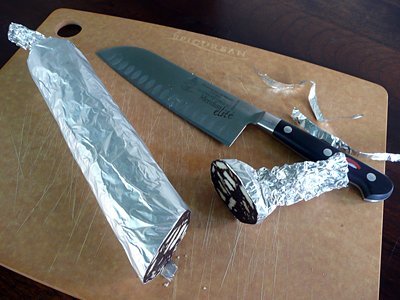 Possible variations
Possible variations
You can replace the rum with Amaretto di Saronno or another sweet liquor, or forgo alcohol altogether if children are involved. In that case, think of ways to keep the mixture moist enough, perhaps by using an extra egg yolk or a smaller ratio of dry ingredients. You've made desserts before; be creative.
You could also incorporate toasted almonds in the mix. Again, think of how this might affect the end result and compensate accordingly. I would probably reduce the amount of dry biscuits in that case.
Something I might try next time is a different packaging, maybe some kind of paper instead of the aluminum foil, but I am not sure yet. It depends on whether I can make the paper stick to the salame before and after cutting it in slices. I like to keep the external "peel" as it feels like the rind of real salame. Another reason is that salame al cioccolato is very buttery and easier to cut when wrapped in something.
P.S.
Ah, yes… as MaryJo pointed out in a comment to yesterday's post, you may want to use your not-so-good knife to cut through the foil. The things I do before my morning caffeine…
It's called research
June 13th, 2008, by Francesca
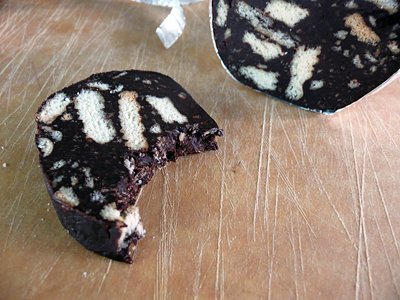
I'm doing research.
What, you don't believe me? It's not like I would *choose* to eat salame al cioccolato unless I had to. And let me tell you, this business of shooting food is harder than you'd think; the food keeps disappearing with every click of the camera. It's a mystery. Of course, with two cats in the house, there's always someone to blame.
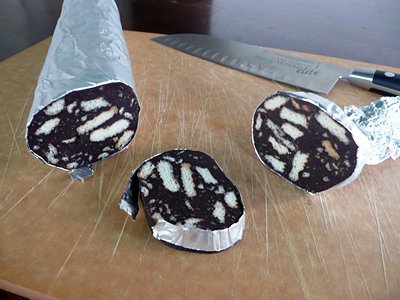
And it's so much work: first you have to peel it, just like real salame.
So, what am I doing making chocolate salame?
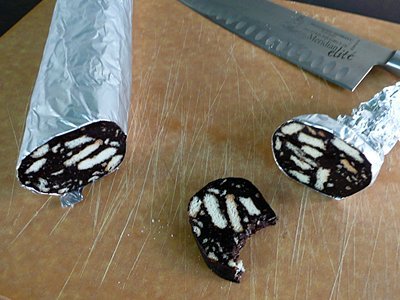
Going…
Yesterday, chef Boyd told us that today we'd be cooking in teams as a way of practicing our teamwork skills ahead of Buffet Day, next Thursday. Today's menu will be entirely different and we'll be cooking just for us, 30+ people instead of 150, but still, it's practice.
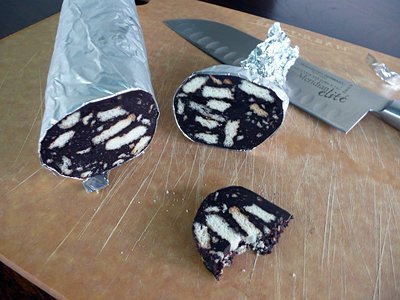
Going…
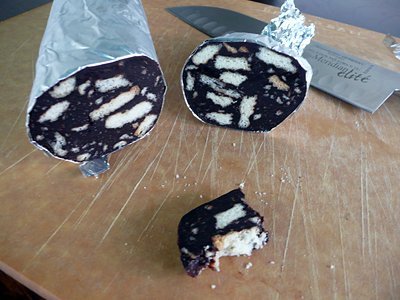
Going…
The menu is being handed down to us with the exception of dessert and I was one of few students who volunteered to make dessert. Since we are cooking rustic dishes (fried chicken and such) I thought I'd go to class with a simple, rustic dessert proposal for my team mates to try out and if they like it, we'll make it. I also expect that we'll be able to make at least two kinds of dessert, since salame al cioccolato is really easy.
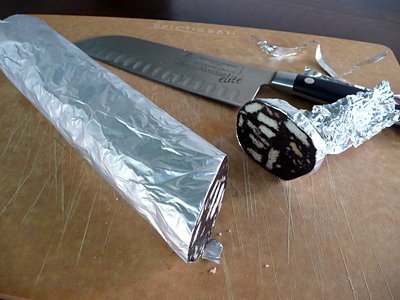
Gone
If the calories don't scare you, I'll post the recipe.
And now I'd better make sure some of this salame makes it to class.
The Program
June 11th, 2008, by Francesca
I've had a few inquiries about how the program works at school, so here's a breakdown of the various classes for those of you who asked.
The whole program lasts a year plus a 3-month externship in a restaurant (domestic or international externship).
Each term lasts six weeks and consists of a lab (cooking) class plus an academic class, as outlined below.
- First term:
- Intro to Culinary Arts 1
- Sanitation
- Second term:
- Intro to Culinary Arts 2
- English
- Third term:
- Baking and Pastries 1
- Applied Math 202
- Fourth term:
- Baking and Pastries 2
- Applied Math 203
- Fifth term:
- Garde Manger
- Culinary World History
- Sixth term:
- International Cuisine
- Introduction to Wine
- Nutrition
- Psychology and Human Behavior
At the end of the rotations, there is a final exam (brutal, I am told) and then the 3-month externship.
So, where does this leave me? Hmm… with another 13 months to go, that's where it leaves me.
Sharpie, sharpissimo
June 10th, 2008, by Francesca
When you use your knives on a daily basis for a variety of cuts, your blades get dull pretty fast. Our school kit includes several knives and a honing steel and I soon found out that the steel only helps with straightening blades, but has no effect on sharpness. There are steels that do sharpen as well, but that's not what we got, so I had to get a sharpening stone.
In school we have an oil whetstone with three sides: coarse, medium, and fine. You oil them with industrial oil and sharpen your knives first on the coarse stone, then the medium and finally the fine one. When I looked for a similar stone in the neighborhood's cooking stores, I couldn't find it. The best I could find was a two-grit water whetstone, and that's what I got.


My whetstone is a Japanese model including two stone grades – medium and fine – and it works with water rather than oil, which is much more convenient as water is a lot easier to come by than industrial oil.

First, you soak the stone in water for about ten minutes. Then you start sharpening your knife on the medium stone by sliding it across the stone in a slightly circular motion. First in one direction, then the other, for an equal number of passes to keep things balanced between the two sides of the blade.

Opinions differ about the specific techniques, but my feeling is that it doesn't matter much which way you go as long as you maintain things equal between the two sides. Some people alternate the right-to-left and left-to-right motion constantly, while others execute all the motions in one direction first, followed by the same number of motions in the opposite direction.
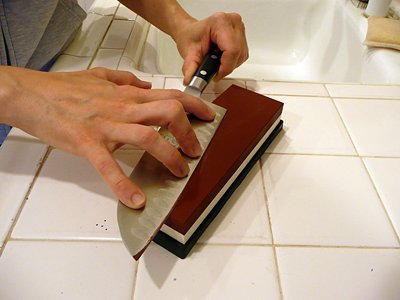
I wish I could have found a stone with three grits, but going with water models means that I would have to buy another double stone (please, feel free to correct me if you know different), most likely with coarse and medium grits. Since these stones don't come cheaply ($90 and higher) I think I'm going to stick with just one for now.

Depending on the kind/brand of knife you have, you are supposed to sharpen the knife at a specific angle, or so I was told at Sur La Table in Pasadena. Others think that the angle is a function of how you hold your knife. Me, I don't worry too much about precise angle measurements and I hold my knives at an angle that feels comfortable to me, which happens to be quite close to the grinding stone, probably less than 20º.

So far, I am sharpening my knives about once a week and try to hone them with the steel daily, but I am not religious about it.
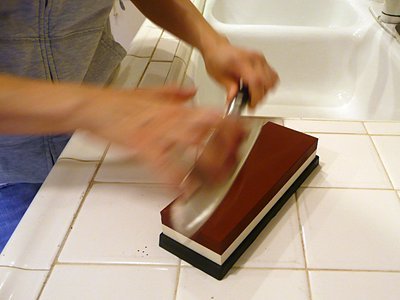
How do you know if your knife is sharp? Ha! Good question.

My chef from Intro 1 (Chef Gore) had several tips:
- Let the knife fall (gently, obviously) on a fingernail. If it "catches", the blade is sharp.
- Try the knife on a tomato. If it slices the skin easily, the knife is sharp.
- Try to slice a piece of paper (chef Gore demonstrated this with a sheet of parchment paper). If the knife cuts the paper on the first pass, it's sharp.
My favorite is the tomato test: it saves my fingernails and seems easier to assess than the paper test.
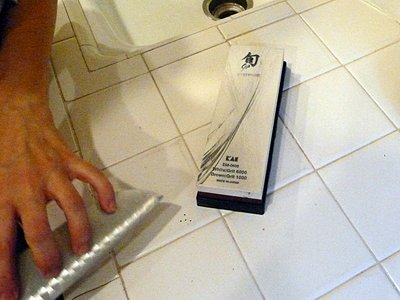
Swish!
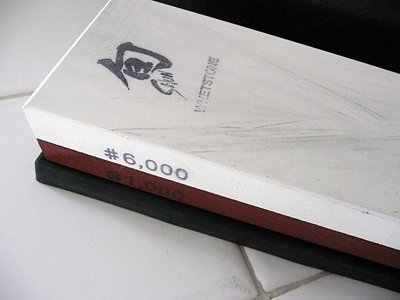
Poor Lamb
June 9th, 2008, by Francesca
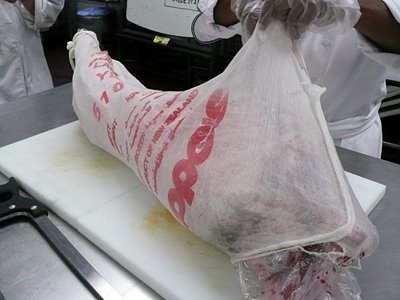
I know some of you are vegetarians and I apologize for the images in this post, but I feel that I have to report on my culinary education in full. I am not a vegetarian and probably never will be, but I am feeling increasingly sympathetic towards those who are and towards the animals being slaughtered for our benefits.
My feelings are actually ambiguous right now, as I am torn between the desire to do no harm and the selfish craving for dishes that bring back fond memories. I never had any qualms about eating any sort of food when I was in Italy, but after not eating certain kinds of meat for many years and finding myself in front of carcasses of baby animals, I am not sure how I feel about the whole thing.
As a knitter and spinner, for instance, I have come to regard sheep as providers of wool and rabbits as sources of fiber as well as wonderful pets. My own brother and some of my friends have pet rabbits and if it weren't for Ben's allergies and our cats' propensities to regard any living being smaller than humans as possible food, we would have one ourselves. I must confess that rabbit used to be my absolute favorite kind of meat and the only reason I haven't indulged in rabbit dishes is its limited availability in Southern California and my reduced exposure to a certain cuisine for the past several years.
And yet, rabbit is one of my fondest memories from when I was living in Romagna and enjoying local cooking, especially eating at a friend's place in the countryside. It's hard for me to give up my memories and what they mean to me, even in the face of my increased awareness of what meat consumption means in this day and age.
But back to culinary school and today's events…
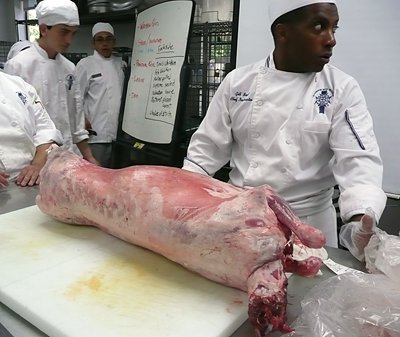
Today marked the beginning of week 4 of Intro to Culinary Arts 2. After poultry, beef and fish, this week is dedicated to lamb, veal and pork and this morning our chef showed us how to fabricate a whole lamb.

Luckily, we won't have to do it ourselves, but seeing the demo was helpful in seeing how certain meat cuts relate to the whole carcass (that ugly word again). Why is it that I have no problem fabricating a chicken or a fish, but a baby lamb upsets me?
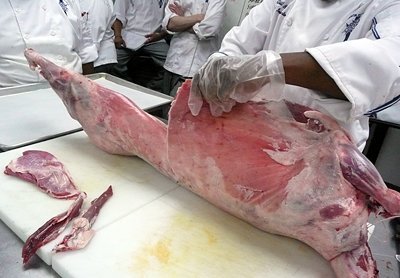
This whole school thing is certainly turning out to be more complex than I had anticipated, and I am not talking only about the moral issues involved in killing and eating other species. Another thing I had not considered is human interaction. After 13 years of living in a cocoon of geek bliss – just me in front of a computer screen interacting as little as possible with the outside world – now I spend at least 30 hours a week in close proximity with 30 people, fighting for burners and oven space, access to sinks, blenders, food mills, a good spot for the demos, etc. Gone from 0 to 60 in less than five seconds, you know what I mean? This may very well be the best thing I could have done for myself; still, it ain't easy.
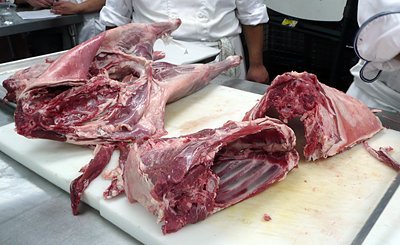
I know, digressing again… Well, lamb fabrication turns out to be a more serious affair than cutting up a chicken or a fish and more serious tools are involved.
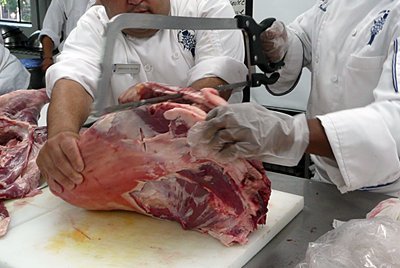
Got saw?
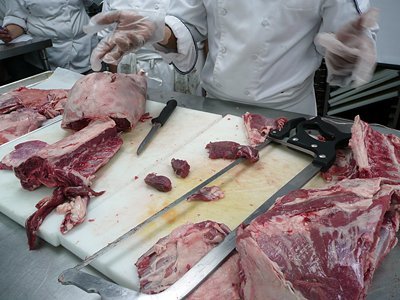
Next week, we'll have a special event called Buffet Day, where both classes in the lab will cook a variety of dishes to share, but unlike Restaurant Day last term, it won't be just us. This time we can invite friends and families. Another difference is that we won't be making our own menus, but follow a menu decided by our chefs.
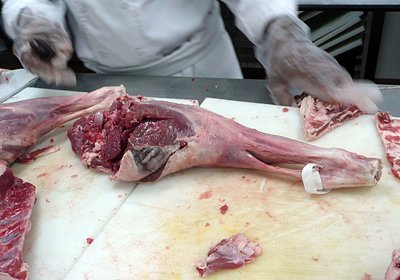
By the way, today's baby lamb came all the way from New Zealand and I was upset at the carbon footprint issues involved in such a long distance shipment, but when I told Ben about it, he pointed out that if the lamb was grass fed in New Zealand, then the shipment may have lesser environmental consequences than if it had been a grain fed lamb in California. Honestly, I don't know if that is the case or not, but it all goes to show how complex the issue of eating responsibly is these days. Eating local sounds better than importing food, but you have to look closely at all the implications on a per case basis. Makes me wish life was simpler.
Briganti
June 6th, 2008, by Francesca
My restaurant review for this term is coming up in week or so and last Friday night we decided to use our weekly outing to go to Briganti, an Italian restaurant in South Pasadena. We had only been there once before for a birthday celebration. Briganti is a little more expensive than our habitual places, but it serves authentic Italian dishes, something a lot less common that you'd think in our neighborhood.

At least half the waiters are Italian and I like that. It always bothers me when I go to a supposedly Italian restaurant and the waiter can't even pronounce the dishes properly. It's also a matter of ambiance and regardless of whether I can understand a language, I prefer the staff to match the cuisine. Mexican waiters in Chinese restaurants bother me just as much as forks in lieu of chopsticks. I want the whole package, from music to decor to utensils, thank you very much.

Ben is much easier to please, as long as there's at least one chicken item on the menu. :D
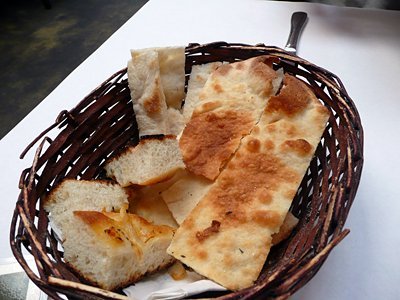
We walked in without reservations – we hardly ever go to restaurants that require that kind of planning – and we met with a little bit of attitude considering that it was early and half the tables were empty. Or maybe it's just my perception… I don't like it when people play hard to get.
But once seated and with a bread basket in front of us, all was well.

The menu had some very attractive items.
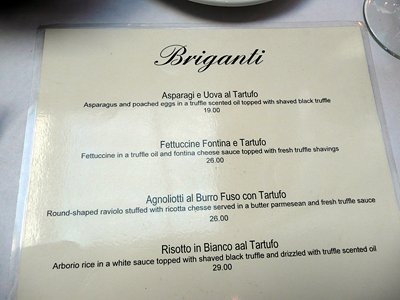
Too bad about the mispellings.
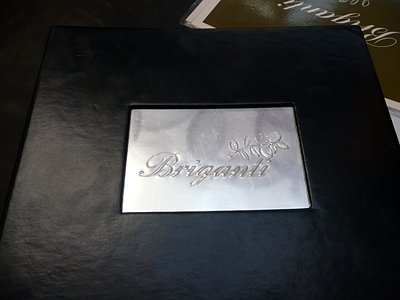
From the wine menu we chose a half bottle of Chianti that we both enjoyed very much.
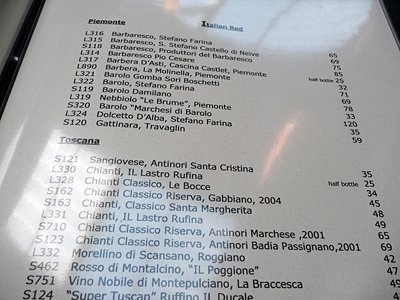
My experience with half bottles is limited and this was my first encounter with a bottle as tall as a regular 750 ml bottle, but thinner.

Here's Ben demonstrating just how narrow the bottle is.
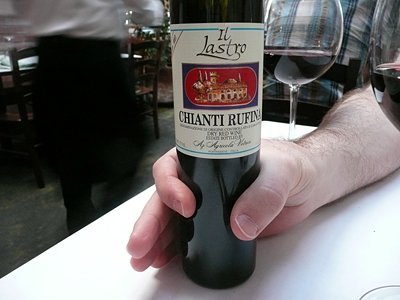
Our first dish was a bruschetta that looked very colorful and appetizing, but tasted rather bland and with over-toasted bread.
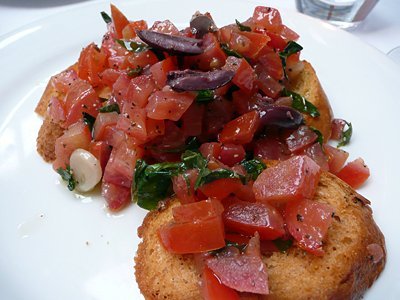
Ben's pizza was very good, thin and crisp with just enough toppings but not too much. We Italians like to actually taste the pizza in addition to the toppings. It's all about balancing the bread and the condiments.

Pizza quattro stagioni
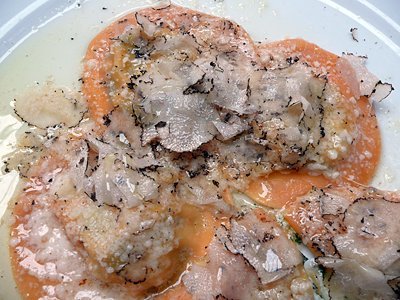
Agnolotti al burro fuso con tartufo (agnolotti with melted butter and truffles)
I splurged and went for the agnolotti al burro e tartufo. It was only tartufo nero (black truffle) but still very good. White truffle would have been out of our range and it's not in season anyway. Our chefs encourage us to save enough to be able to experience good restaurants and fine dishes every now and then and I couldn't agree more. When Chef Gore mentioned truffle in class last term, most of the students (maybe all) thought she was talking about chocolate truffles!
Hm, digressing again… the agnolotti were highly satisfying. Cooked perfectly al dente and served with melted butter, flavorful Parmesan cheese and just the right dose of truffle shavings. Yes, paper thin shavings, but you don't need a lot of tartufo to turn a good dish into something special. The dish cost $26 and didn't take long to obliterate, but it was worth every penny.
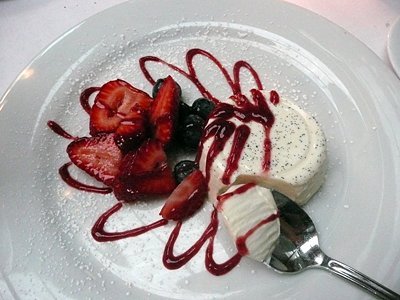
We don't usually get dessert but this time we got two: panna cotta…
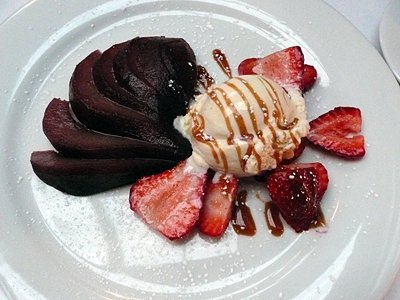
and pere al vino rosso (poached pears in red wine).
Unfortunately the pears contained cinnamon and I couldn't share them with Ben (I'm allergic to cinnamon). Not a problem, though, because I was very happy with my panna cotta.
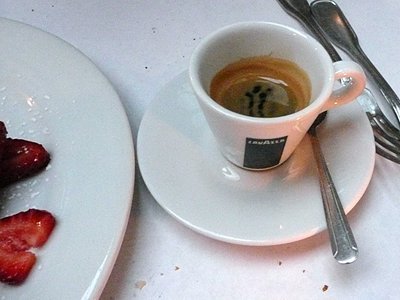
And to end properly, an espresso ristretto.
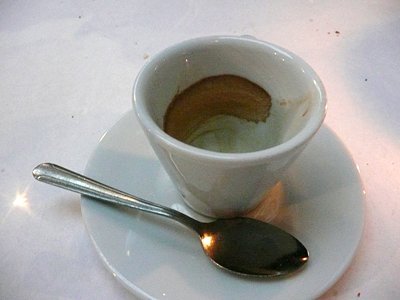
By then, the light was changing and the atmosphere with it. I love dusk and the colors it throws onto things.
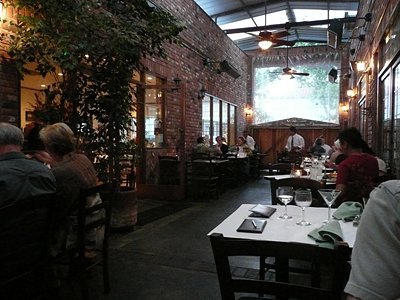
Briganti is not a restaurant we can patronize on a regular basis, but we will be back.
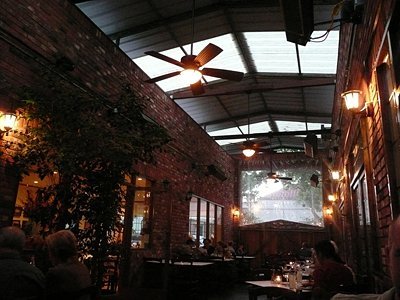
Alla prossima! (to the next time)
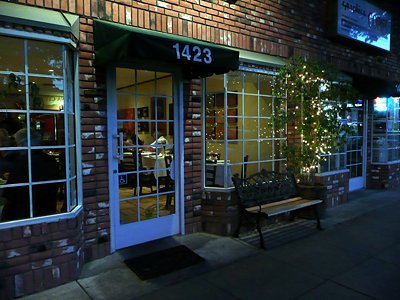
Singularity
June 5th, 2008, by Ben
Ben, here. Despite rumors to the contrary, Francesca has not been starving me nor threatening me with knives. Shame on you for thinking that. It’s simply been the case that I have either been programming or eating, with little time in between to post about these exquisite dishes she brings home.
I recently read in the New York Times that 27% of the food in America gets thrown out. And America is far from the worst offender. [If the topic interests you, more good reading at Wasted Food.] So, I decided to make it a higher priority not to throw out any food that makes it to us. This means deciding what to eat based on shelf life, not just my mood. It means trusting my senses about whether food has gone bad, and not blindly obeying excessively cautious "please don’t sue us" expiration dates and "danger zone" times-and-temperatures that Francesca must adhere to as a chef. And since we have a stream of food coming home now, I am the leftover king, and nothing exceeds my grasp.
Actually, more like Gray Beard, The Leftover Pirate™. The Governess Francesca stocks her refrigerator fortress high with delectable treasures, which she hopes to some day partake of when her duties permit. But when she returns from her voyages abroad, once again she finds her treasure trove plundered and empty. Aboard my frigate, I savor my spoils: “Avast, me hearty. I be of two minds twither a bottle o’ rum goes with chicken roulade. Mayhap we uncork a nice Beaujolais from ye cellar below decks? Arrr.” I imagine a wooden leg, and a hook-hand with a nice, flip-out cork screw attachment, for the fully equipped and high-tech food pirate.
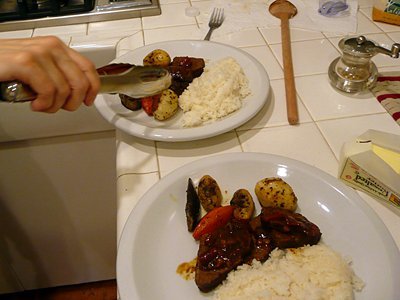
I have fond memories of the occasional pot roast while growing up. Both of my parents worked non-standard hours, so slow-cooked items were great. Pot roasts were rare (meat loafs unfortunately less so), but always a good idea because one could be left to cook while you were away at work and it turns into leftovers so well: thinly sliced it could become sandwiches, cubed it could be added to bean-based soups, when coupled with a sauce from its juices it will reheat well without drying out, and it's so tender that it's one of the rare beef dishes that can even be eaten cold.
Francesca made a single-portion Italian pot roast [No Italians were harmed in the making of this roast. -Ed.], which upended some of these preconceptions. First off, I understand that they don’t have 8 hours to let it slow cook, which may be the primary reason to keep the dish small. Still, a pot roast usually is large, with half of it serving 6 people, and needs to be carved or sliced to serve it. Carving a roast is an art unto itself, one which generations of heads-of-the-table would pass on, parent to child, like grandma’s good silverware or the ability to wiggle your ears. Single serving? What were they thinking?
But these chefs seem to know a thing or two about food, and all the differences from what I expected now seem driven by the need to take advantage of what I (at first) thought was a shortcoming. A single serving has more surface area; so rub spices on all sides. A single serving won’t render much fat; add a complexity by using pancetta fat. A single serving won't cook long; make the flavors dense by reducing a sauce on the stove before it goes in the oven. Given their tendency to have the proto-chefs cut and chop everything they need, I even suspect that the dried herbs and spices were used not for their expediency but for some sinister and scrumptious purpose of which I am not privy.
Genius. Delicious. The sauce had tang without the dish being about the sauce. The meat was tender and moist, despite being reheated. The oregano and herbs were obviously present, but didn’t turn this dish into yet another “inspired by real Italian cooking” American concoction. My only complaint: it was a single serving.
What’s a poor leftover pirate to do when he can't go back for seconds? “Jolly Roger,” my wooden leg! Hrmph.
Poaching
June 3rd, 2008, by Francesca
Today's demo and subsequent cooking session involved:
Moules Marinière (mussels alla marinara)
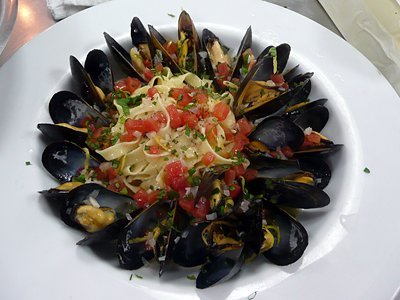
and Poached Salmon with Hollandaise Sauce, Gaufrette Potatoes and Steamed Vegetable Medley.
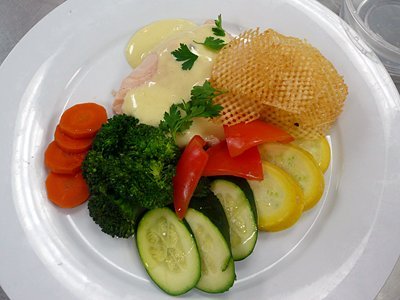
We encounter new words daily and my vocabulary list has already reached the minimum of 75 words required for the glossary to be included in the class notebook. Now of course I have to come up with definitions for all the words as we are not supposed to just copy them, but rather make our own. This term, French words make up the great majority of my glossary.
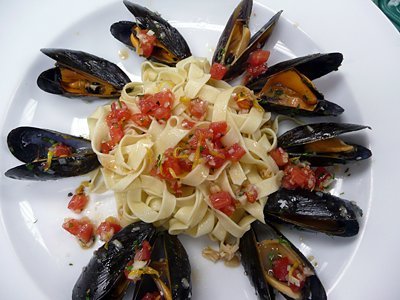
My mussels dish didn't look as good as the chef's demo, in part because we had a smaller allotment of mussels to work with but also because my sauce reduced too much and I didn't have enough liquid for the dish.
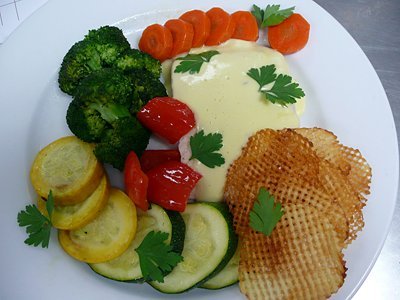
The poached salmon came out well, but I let my broccoli cool off too much during plating.
Salmon
June 2nd, 2008, by Francesca
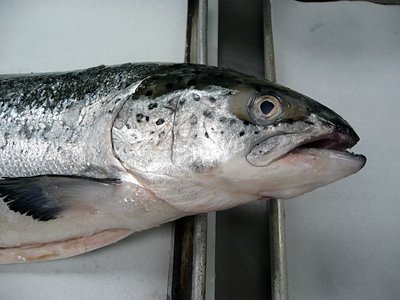
The salmon has begun. After the written test, chef threw us a curved ball by assigning us a dish entirely from last term, no beef, no chicken, no nothing from our first two weeks in Intro 2… instead, we had to cook a breakfast dish made of Pommes Anna, eggs over easy and glazed batonnet carrots. WTF? At least I finally got a hang of Pommes Anna, my bête noire. Where was I? Ah, the salmon… so, after the practical, chef demoed how to fab a salmon, and we all got a salmon of our own to practice on.
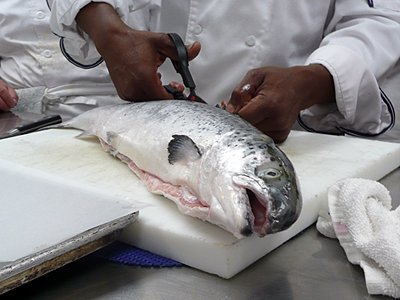
The salmons were farm raised and already "drawn", which means that the viscera had been removed. So here's the sequence from drawn fish to cleaned, portioned fillet tranches.
First, using shears, cut off the fins.
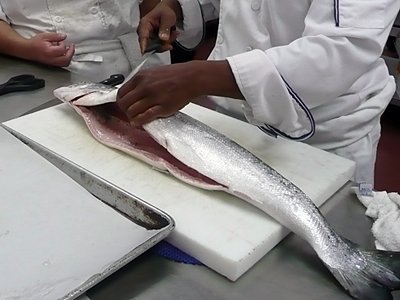
Then, with a preferably flexible boning knife, cut behind the gills on one side of the fish stopping at the backbone (spinal bone).
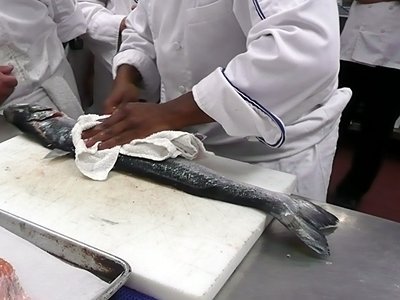
With a chef's knife, shift by 90º and start cutting horizontally on top of the spinal bone. As you slide the knife from head to tail with a sawing action, you hear a click sound every time you cut through one of the bones close to the backbone. Keep checking how you are doing to adjust the angle of your knife as needed. Repeat sequence on the other side to cut the second fillet.
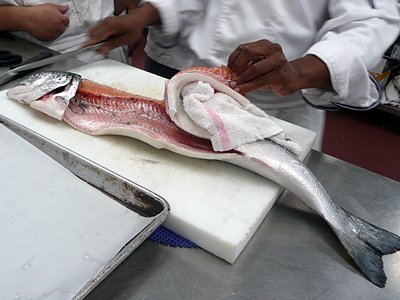
Here is the fillet before clean-up; the whitish part on the lower right of the picture is the rib section that needs to be removed, again with the boning knife. BTW, the knife suggestions are just that – suggestions – but as I was doing what I had watched in the demo I could see the rationale behind the different knife choices. And your knives should be really sharp.
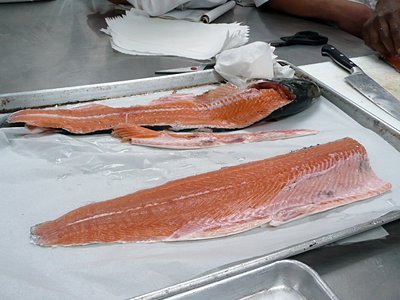
Here is the skinning of the salmon. Grab your fillet at the tail end with your non-dominant hand and use a chef's knife in your dominant hand to start cutting close to the skin going from tail to head and away from you. Check as you go to make sure you are not too close to or too far from the skin. Too close and you end up with too much to clean; too far and you are wasting precious flesh.
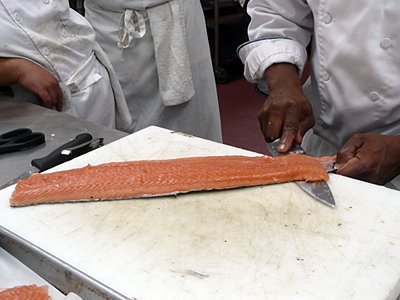
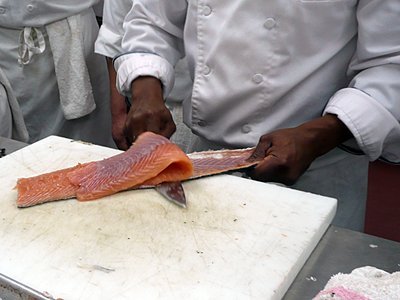
One of the things that require cleaning is the bloodline, the darker part of the flesh that carries blood to the fish and keeps it warm in cold waters. I am not sure, but I think it's mostly a question of aesthetics.
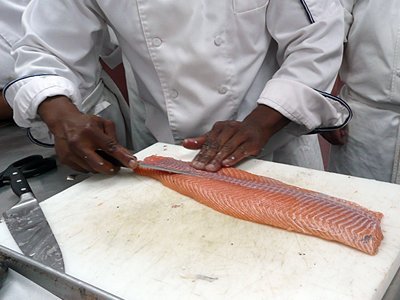
The bloodline is right under the skin while on the other side is a thin white line of cartilage, that is usually also removed. In this case, it's a combined presentation/taste issue as the cartilage has a different texture from the flesh around it. And lastly, you have to pull out all the pin bones with tweezers or pliers.
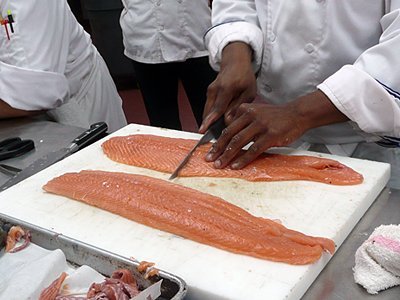
The cleaned and portioned fillets.
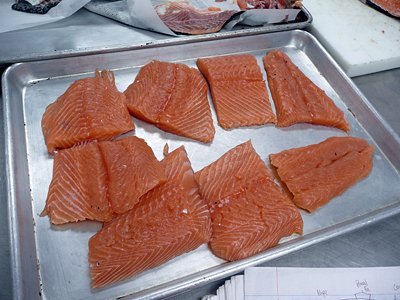
My side of the lab with most of us ready to start work on our salmons.
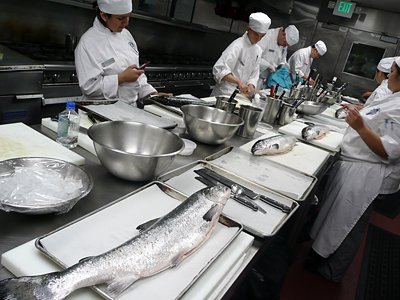
I did a rather good job, other than the last tranche of one fillet, and I was rather slow. Maybe I'll sign up for a skills enhancement workshop on Thursday night or Saturday morning to fab another salmon and get extra practice, not to mention bringing home a whole salmon. :) Hey, with what they charge me for tuition I feel entitled to grab a salmon here and there, you know.
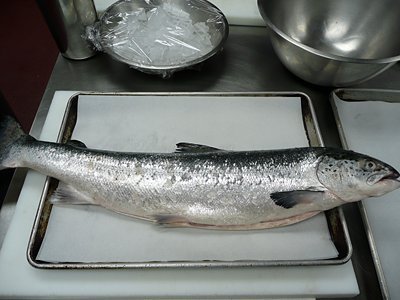
By the way, why is salmonella something to do with chicken? If English worked the way Italian does, salmonella would be a cute female salmon.
Finalmente!
June 1st, 2008, by Francesca
Finally, finally, I added audio files to lesson #2: Hunting down your food.
I know it's taken me forever and you probably thought I'd never get around to it. Sorry about the delay. Also, I am very slow recording and editing audio files so I only recorded one reading per file. I still have to add audio to lesson # 3 (Al bar) and hope to do that next weekend.
Pot Roast
June 1st, 2008, by Francesca
Chef started off with a demo of how to clean a beef tenderloin. First, he separated the chain from the tenderloin…
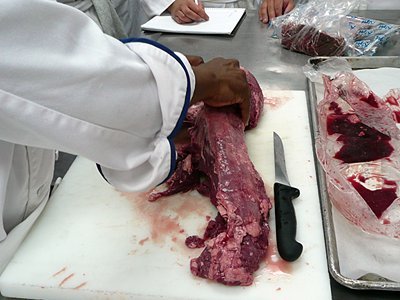
… then cut off all the elastin, the yellowish connective tissue that, unlike collagen, does not break up with cooking…
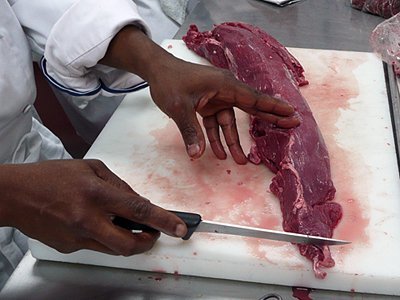
… and portioned off the meat for individual dishes.
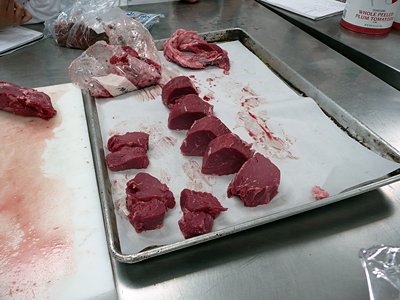
Then he showed us two ways of tying a piece of meat: loop knots and square knots. I like things easy so I'm going to stick with regular (square) knots. After the tenderloin demo, we cooked a pot roast dish, using a cut of beef called chuck, which is beef shoulder.
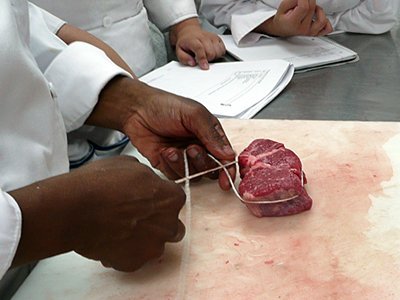

We rendered some pancetta in a pan, removed it and seared the meat – seasoned with salt, pepper and dried herbs – on all sides. We removed the meat from the pan, added the mirepoix (chopped onion, carrot and celery), put back half of the pancetta and added some minced garlic. Deglazed all with red wine reducing to demi-sec (reduced by about half) and added a bay leaf and equal parts of tomato sauce and brown veal stock. Brought it to a simmer, covered with foil and put in the oven at 350º F for about two hours. If you have 5-6 hours available (yeah, right) you can also cook it at a lower temperature, as low as 300º F.
When the meat was ready, we took it out, strained the sauce and put everything back in the pan on the stove to adjust the consistency of the sauce. This sauce should not be seasoned, because it gets reduced a lot and ends up concentrated and flavorful from all the ingredients and the seasoning on the meat. Don't say I didn't tell you.
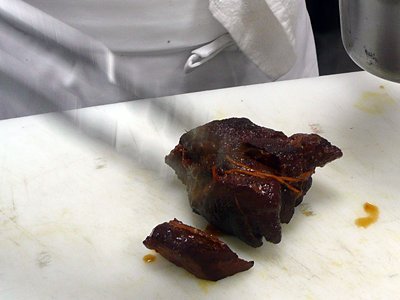
We served the pot roast with a bunch of vegetables, alas, to be cut mostly as tournés. Cutting tournés is not one of my favorite pastimes; it's time consuming and wasteful and I take issues with both things. We parboiled the potato and carrot tournés, sautéed the zucchini, squash, eggplants, red bell peppers and onions, added the potatoes and carrots and some dried herbs and finished roasting all in the oven (6-8 min).

Although I am not a beef fan – I only cook beef to make ragú – the pot roast was really tasty. They call it Italian pot roast, but honestly, I've never known anyone in Italy who uses dried thyme or dried basil. And the only way I've ever used dried oregano before has been on pizza alla marinara. Here, if any form of oregano appears in a dish, it's automatically labelled Italian. Go figure.
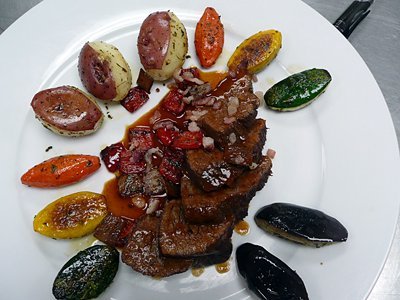
Yeah, I went a little overboard with the plating; I should have done the rustic thing and mixed it all together. I actually prefer rustic cooking and presentations; I don't know what came over me.
Every Monday includes a written and practical test and tomorrow we'll have to cook a beef dish for our practical. After that, no more beef until finals week, something I am actually relieved about as I find the smell of raw beef mildly unpleasant. Starting Tuesday we'll be cooking fish. Yay! I love fish and am really looking forward to the fish and shellfish dishes.
CORRECTION
Edited on June 20, 2008.
I don't know what I was thinking when I wrote this post, but the cut of beef we used for our pot roasts was chuck, a cut from the shoulder, not tenderloin. Sorry about the confusion!



